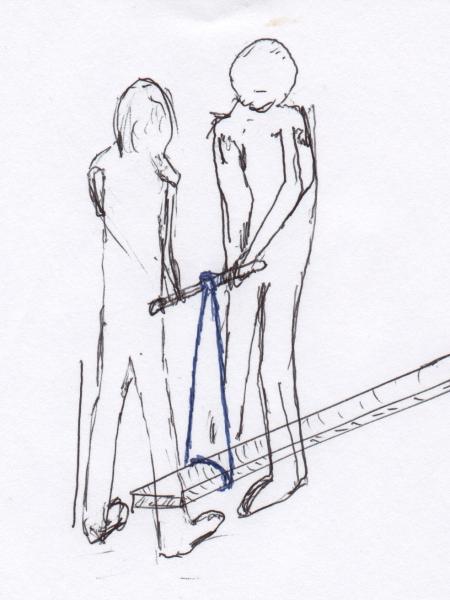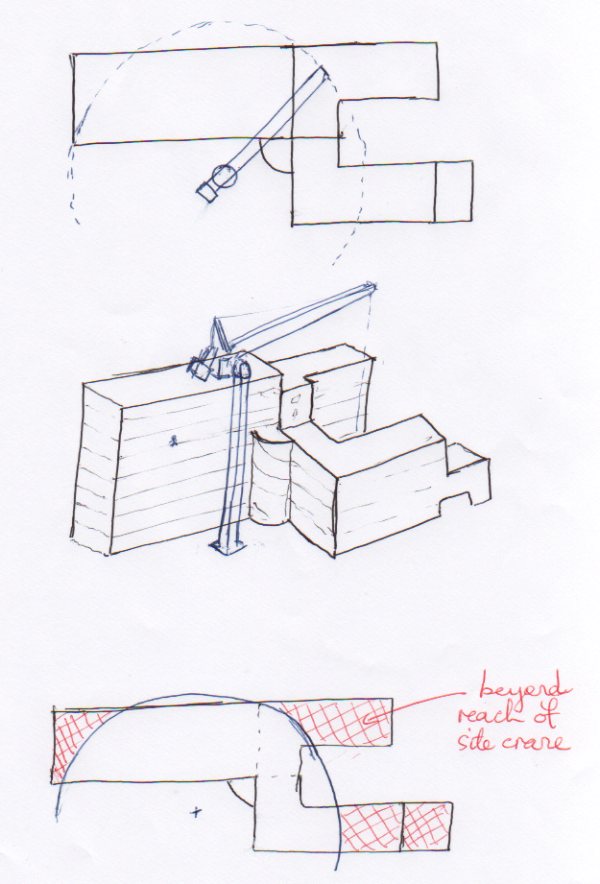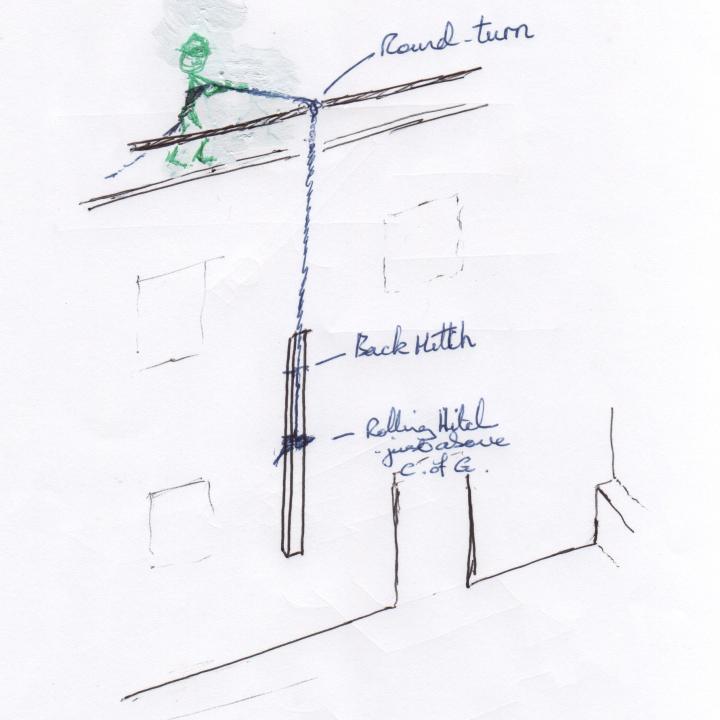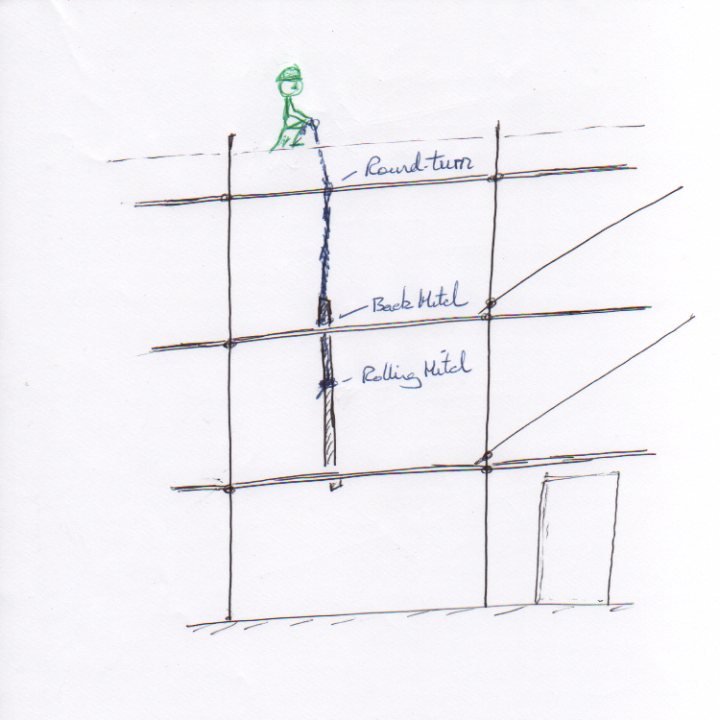
I worked in construction through all of 2007 and 2008. My Trade was welder-fabricator and steel-erector. I worked in steel fabrication company ("FabCo") workshops and out on site erecting / fitting steels made in the workshop.
I worked happily in all this time. In Autumn 2008 external events impinged on the work environment. "Managers" started turning up at site attempting to prohibit rope use, citing "Health and Safety legislation", then giving work instructions to do the same tasks so dangerous that we had to point-blank refuse. These moments were fairly ferocious - experienced steel-erectors refusing to get injured whatever the threat and "managers" trying to deliver enough threats to make those things happen.
Now - big picture - rope has been around since the dawn of human civilisation. It is possible that the first plant cultivation was for rope. Not food. Well; someone who spend time living in a recreated "early human settlement" bet they cultivated plants giving rope + some food + medications + ... But you see the point I'm making. These edicts encountered were definitely "idiot" in character.
Innumerable uses of rope are small tasks aiding a manual lift. You transfer the position of lift to help the person. Or make it possible for more than one person to participate equally in the lift. Example sketch follows, where the rope transfers the manual lift to a steel tube handle.

This shows two people moving a very heavy steel around on the floor. The steel only has to hover at one end just above the floor for that end to be swung to its destination. Crowbar up and chock the other end, slip the rope around that end and that too gets swung to its destination, putting the entire steel where it is wanted. Daily minute-by-minute work in the steel construction trade.
Some techniques using ropes out on construction sites are "headline" skills of the Trade. One of the most valuable is illustrated here.
First - context. When fitting steel details on concrete buildings, the site crane often cannot cover the entire site. There were two or more cranes during the concrete pour - but that was expensive in crane hire and the obligation to have a Crane Coordinator directing lifts and ensuring cranes did not collides with each other in their arcs of overlap. So now with the concrete "frame" structure up, there is one tower crane remaining while all the other Trades fit-out the building. Sketched is what the situation might be like:

So as the steel gang, you can have steels craned onto a roof area within the crane's reach where that roof is contiguous with the work area. But the steels are above where they have to go. So you move them, perhaps by a trolley, to the required roof edge. Then you do this - the sketch is simplified but gives the overall idea before more technically accurate sketches.

You rope-up the steel with its Rolling Hitch and Back Hitch, get your rope Round-turn'd around a sufficiently strong tubular structural object which is in the right place, then while one person controls the rope outboard of the Round Turn the rest of the gang slide the steel over the edge of the building. Everyone can stand clear while the one person on the rope lowers the steel. One person can fully control any weight descending on a Round Turn. A typical steel in this situation might be 125kg weight (not heavier, so two people can move it on a floor). See "Using round turns" (1/4page down) explained in more detail previously.
In reality, there is usually scaffolding up, enabling the various trades such as glaziers, renderers, etc - and steel-erectors - to access their work areas. This scaffolding provides secure tubular members to work with. Typically as follows.

In this case I have intimated that the steel is being lowered within the scaffolding and scaffold boards are being lifted as and when required to enable vertical travel of the steel through the scaffold deck levels.
Methods of this ilk are tried-and-tested and passed down through the generations in the Trade. Although impressive, they are very safe. No-one is under the load - none of the steel gang are and you enforce that no-one else is. If the steel were to drop, the consequence would be very low (you don't proceed if that is not the case) - perhaps chipped concrete needing rectifying, broken paving slabs - nothing that won't go past without comment balancing up the big scheme of things. And this never happens in reality, anyway... In this case of passing through the scaffolding, you don't lift boards below the level you are lifting at, so a load drop wouldn't fall far onto the next scaffold deck - not enough to endanger the scaffold. And you replace all but one board above after the steel has passed through (the rope still has to pass).
Then there's the question of rope strength and safety margins. And here are the answers in the campaign of testing described also on this site around May 2009. The answer is - the safety margins are very adequate.
Tests done on 10mm rope and gave around 900kg of load-bearing capacity even when knots are present. On site for this type of activity the smallest rope you use is usually 12mm diameter - which means you have more than 1.4times the strength from cross-sectional area. So it's looking like safety margins are around 10X with the heaviest loads you'd judge appropriate.
We were totally mystified by where these edicts were coming from.
But something was very clear - this was a crisis, because when I did a "risk analysis" I found the risks associated with the "alternative" working methods were horrendous - something like 100000X (one-hundred-thousand times) the risk of the traditional with-rope methods. That meant going from an incident which you might never see in an entire working lifetime to a certainty of being injured within a few days.
Here are my contemporaneous notes with my risk assessment as this "crisis" erupted around us in Autumn 2008. They form a PDF of 220kB size. Towards the back of it you will find pages where I consider what might be an appropriate program of regular testing should that prove necessary to get things back "on an even keel". And these thoughts are the genesis of my testing program happening as I provide these notes in Spring 2009 ( Rope testing program page).
So I saw a serious problem! (as did everyone else)
We noted mention of "a legal requirement" for "lifting equipment to be tested".
So I started research of what the Government legislation (and Gov't guidance) actually says, what the "formal" methods/styles of risk assessment and risk management are, etc, etc.
One of the first things I found written in plain and simple words by the Government itself regarding its own Health and Safety at Work Act was immediately helpful. If a hazard is identified the action taken must reduce the risks. So edicts which increase the workforces' risks (or anyone else's risks) cannot be "required by Health and Safety legislation". End of story. Well, almost. I made sure I read a lot more of the legislation and guidance so I knew what the future must look like.
And it just so happens that I moved into a job in a different technical field where I needed this knowledge. Which I continue to develop as part of my job...
What I do know is that those coming with these edicts massively failed to comprehend the meaning of Government legislation. I haven't developed sufficient knowledge to be able to assert what it all means. But I do know broadly what you have to do in work. For lifting equipment in the UK you do need to know the "working equipment" regulations (esp. "PUWER1998") and you do need to know the specific lifting equipment regulations ("LOLER1998") (at time of writing - May 2009). What I would say is - if you come into contact with these issues, don't rely on hearsay - read them. You might be in for a surprise leaning towards the better direction. The Gov't publishes the legislation for easy access on the OPSI website. Use a search engine and find the Government guidance publications as well - on the HSE website.
You certainly do need to at least inspect Lifting Equipment. And there must be a "Competent Person" who can evaluate whether the equipment needs testing. For a rope you would certainly visually inspect it for damage or excessive "wear-and-tear". And testing - it certainly would be in keeping with the regulations to lift a deadweight of say 5X the intended working load. That doesn't have to be highfalutin'. You must record the details of your test (legislation says what you must record, minimum). If you lift a sack of shingle using the rope suspended it from a crane-hook as your test, that would appear to be fine so long as you record what that weight is, how the test was conducted, when it was done, where it was done, who did it, etc. Read the Regulations and Government guidance.
The "Competent Person" is interesting. For rope-work that would be the sort of senior Tradesperson you always have on a construction team. Someone who has been in the business for 30 or 40 years or more. Exactly as you work without the legislation having ever existed. Not doing what you are not familiar with on your own without a "mentor" present.
High academic qualifications and academic ability however "bright" cannot on its own make someone "the Competent Person" - that is absolutely clear from the legislation.
The first one on that amazing day was to "handball" (manually carry) the steels down the scaffolding-stairway. Scaffolding-stairways are very lightweight, swaying around at the best of times. And the best of times didn't prevail in this case. Scaffold stairways provide a requirement for there should be more than one way of leaving to workplace, so that one event cannot both create a danger and deny an only escape route. And they are an open framework. So when the inevitable trip happens, like as not the steel goes flying out on the stairway and has free fall 5 floor levels down onto the busy working area below.
Even I as a junior singled out alone gave an answer than this instruction was not going to happen ever in the entire remaining existence of the Universe. Choosing the next person to try to pressurise one-to-one, a good blast of Anglo-Saxon vernacular punctuated the tranquility of the day.
And so existed the stalemate in which I started this investigation of Health and Safety legislation.
The following illustration shows a practice which did happen for a time.

As you can see, it is risky because you have people beneath the load while folk above struggle to manually control the load into its descent. Given floor-to-floor heights the workers below have to stand right under the steel with arms outstretched vertically upwards to fullest extent trying to get support to the load and guide its descent. Then you have bad lifting operations lowering the heavy steel to the scaffold deck at each level.
Maybe the origin of my enthusiastic drive with the rope testing program has come into view. These are good techniques, very safe and enable good manually performed steel-erecting operations. I've worked with people above the normal age of retirement who have been something like 50 years in the business and with the traditional rope techniques have shifted more work more easily that "bull in a China shop" younger gangs. The feeling of seeing steels going into place in relaxed control, pacing work from break to break, seeing good accumulating progress while cruising through the day is very satisfying.
R Smith, May 2009